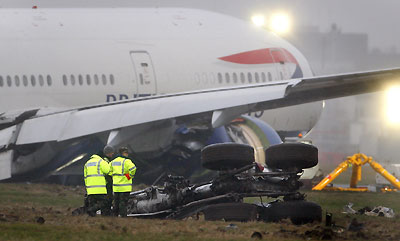Engine problems blamed for Heathrow crash-landing
Updated: 2008-01-19 10:55
 Accident investigators view debris from a British Airways aircraft sitting on the edge of the runway, following an emergency landing at Heathrow Airport in London January 18, 2008. [Agencies] |
LONDON - Investigators said on Friday that the engines of a British Airways Boeing 777 failed to respond to demands for more thrust shortly before it crash-landed at London's Heathrow Airport on Thursday.
Thirteen people were injured when BA flight 83 from Beijing came down well short of the southern runway and the 136 passengers were evacuated down the aircraft's emergency chutes as fire crews doused the plane with foam.
Giving details of its initial investigation, the Air Accidents Investigations Branch (AAIB) said: "At approximately 600 ft and two miles from touch down, the Autothrottle demanded an increase in thrust from the two engines but the engines did not respond."
"Following further demands for increased thrust from the Autothrottle, and subsequently the flight crew moving the throttle levers, the engines similarly failed to respond."
The AAIB said the flight had been normal until the plane made its final approach for landing. It said 13 people had been injured, one passenger seriously.
It said the investigation would now focus on a more detailed analysis of information from the flight recorder and other recorded data, and examination of "the range of aircraft systems" that could affect the engines.
Captain Peter Burkill, given a rousing reception by staff at the airline's headquarters, declined in a brief statement to reporters to make any comment on the cause of the crash.
But he praised his crew for demonstrating "the highest standards of skill and professionalism," thanked the passengers for "their calmness and good sense" and praised the emergency services for reacting so speedily.
He said it was his co-pilot, John Coward, who had been at the controls during the difficult last minutes of the flight.
SPECIALISTS ARRIVE
A team of specialists from Boeing arrived to join air accident investigators and experts from Rolls Royce, who are expected to take several months to find the cause of the crash. The aircraft was powered by two two Rolls-Royce RB211 Trent 895-17 turbofan engines.
Heathrow, the world's busiest international airport, was struggling to return to normal.
More than 50 flights were cancelled on Friday morning, but British Airways said it planned to operate all its long haul flights and up to 90 percent of short haul departures.
Prime Minister Gordon Brown, whose flight to China to promote business ties was delayed by the accident, praised the crew of the airliner.
"I think it's right to pay tribute to the calmness and professionalism of the BA staff and the captain, and what he achieved in landing the plane," Brown told reporters shortly after his arrival in the Chinese capital, Beijing.
Part of the plane's undercarriage, which parted from the fuselage when the aircraft hit the ground, lay in the grass several hundred metres (yards) from the runway.
|
|
|
||
|
||
|
|
|
|